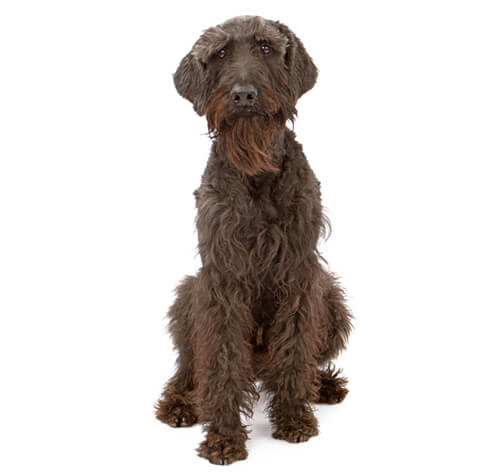
Distinguished by his bearded muzzle, the Giant Schnauzer is a robust, powerful dog originally bred to drive livestock. He loves having a job to do, and this natural guard dog considers his most important task to be protecting his human family. Highly energetic, the Giant Schnauzer should be vigorously exercised daily. His lightly shedding, coarse coat requires weekly brushing and clipping or stripping four to six times a year.
DID YOU KNOW? A descendant of the Great Dane, the Giant Schnauzer was developed in Germany, where the breed is called the Riesenschnauzer, meaning “the giant.” The breed historically has also been referred to as the Russian Bear Schnauzer and the Munich Schnauzer. Highly intelligent and easily trained, the Giant Schnauzer was used as a police and military dog during World War I. The Giant Schnauzer is not actually a giant breed, but rather, the largest of the three Schnauzer breeds. The other two are Miniature and Standard.
ALSO KNOWN AS: Munich Schnauzer, Munchener, Russian Bear Schnauzer
The need-to-know
- Dog suitable for experienced owners
- Extra training required
- Enjoys vigorous walks
- Enjoys walking one to two hours a day
- Large dog
- Minimum drool
- Requires grooming every other day
- Hypoallergenic breed
- Chatty and vocal dog
- Guard dog. Barks, alerts and it's physically protective
- May require training to live with other pets
- May require training to live with kids
Personality

The Giant Schnauzer should look strong, alert and imposing, but be good-natured in temperament. A natural watchdog, they will be vocal to get your attention if necessary, and will need polite introduction to new people rather than assuming friendship on sight!
If well socialised, the Giant Schnauzer can get on well with other animals, but are generally better with dogs of the opposite sex.
History and Origins

Country of Origin: Germany
The original ancestor of the Giant Schnauzer is unsurprisingly, the Standard Schnauzer. Cattlemen from Bavaria found they needed a larger dog for working their cattle over long distances and created the breed using other pastoral types including Great Danes, Rottweilers and possibly the Bouvier des Flandres. Since then this tough, working breed has found popularity as a very effective police and security dog.
Nutrition and Feeding

Large breed dogs, as well as having large appetites, benefit from a different balance of nutrients including minerals and vitamins compared to smaller-breed dogs. The Giant Schnauzer is also prone to bloating and stomach problems. Smaller, more frequent meals can help minimise this risk. Discover more about how to offer your dog a balanced diet with our easy-to-follow guide.
Exercise

Two hours a day or more, of dog exercise with walking, training and games included will be needed to keep the Giant Schnauzer content. This is an athletic outdoors dog, not put off by wind and rain due to his protective, weather resistant coat. Although smart in appearance, the Giant Schnauzer’s trousers and beard will pick up water, mud and debris and so need drying and checking after each walk to clean up.
Other Information

Health and Common Issues
As with many breeds, the Giant Schnauzer can suffer from various hereditary eye disorders, and hip dysplasia (a condition that can lead to mobility problems). Eye testing and hip scoring of dogs prior to breeding is therefore important. Epilepsy and a particular type of cancer of the toe are also encountered relatively frequently.
Space Requirements
The Giant Schnauzer is a large dog with a coat that collects muck, water and debris, so may not be suitable for the smaller home. A large garden offering space to train and play in, and access to a variety of walking routes will help keep them mentally satisfied. Given their vocal, guarding nature, this is a dog who needs space and will be potentially over stimulated and stressed by constant noise from neighbours or traffic. Quiet suburbs or rural living will suit the Giant Schnauzer better than busy town or city.
Training Giant Schnauzers
The Giant Schnauzer is suited to those who enjoy dog training and working with their pet. Early dog socialisation is vital to ensure they are relaxed and happy in the presence of other dogs and animals, as this breed has guarding tendencies and will react to unfamiliar sights and sounds. Well capable of competing in a variety of dog sports including tracking, Cani-X and obedience, this is a dog who needs a job to do.
Best Family Dog Breeds
The Giant Schnauzer is still very much a working, guarding breed and therefore better suited for those with older children or teenagers. As puppies and juveniles they are big, boisterous and bitey, not an ideal combination with children. This is also a dog who requires several hours exercise and training per day which will take up a reasonable amount of time and energy making them less suitable for the young, busy family. While many dogs are traditionally thought of as being good with children, all dogs and children need to be taught to get on with each other and be safe together. Even so, dogs and young children should never be left alone together and adults should supervise all interactions between them.
Did You Know?
- The Giant Schnauzers moustache and beard are so important to the breed it is actually where their name originates. The term comes from the German word for ‘snout’ and colloquially means ‘moustache’ or ‘whiskered snout’.